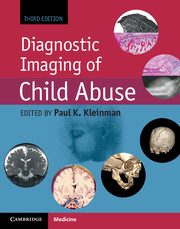Book contents
- Frontmatter
- Dedication
- Contents
- List of Contributors
- Editor’s note on the Foreword to the third edition
- Foreword to the third edition
- Foreword to the second edition
- Foreword to the first edition
- Preface
- Acknowledgments
- List of acronyms
- Introduction
- Section I Skeletal trauma
- Chapter 1 The skeleton: structure, growth and development, and basis of skeletal injury
- Chapter 2 Skeletal trauma: general considerations
- Chapter 3 Lower extremity trauma
- Chapter 4 Upper extremity trauma
- Chapter 5 Bony thoracic trauma
- Chapter 6 Dating fractures
- Chapter 7 Differential diagnosis I: diseases, dysplasias, and syndromes
- Chapter 8 Differential diagnosis II: disorders of calcium and phosphorus metabolism
- Chapter 9 Differential diagnosis III: osteogenesis imperfecta
- Chapter 10 Differential diagnosis IV: accidental trauma
- Chapter 11 Differential diagnosis V: obstetric trauma
- Chapter 12 Differential diagnosis VI: normal variants
- Chapter 13 Evidence-based radiology and child abuse
- Chapter 14 Skeletal imaging strategies
- Chapter 15 Postmortem skeletal imaging
- Section II Abusive head and spinal trauma
- Section III Visceral trauma and miscellaneous abuse and neglect
- Section IV Diagnostic imaging of abuse in societal context
- Section V Technical considerations and dosimetry
- Index
- References
Chapter 4 - Upper extremity trauma
from Section I - Skeletal trauma
Published online by Cambridge University Press: 05 September 2015
- Frontmatter
- Dedication
- Contents
- List of Contributors
- Editor’s note on the Foreword to the third edition
- Foreword to the third edition
- Foreword to the second edition
- Foreword to the first edition
- Preface
- Acknowledgments
- List of acronyms
- Introduction
- Section I Skeletal trauma
- Chapter 1 The skeleton: structure, growth and development, and basis of skeletal injury
- Chapter 2 Skeletal trauma: general considerations
- Chapter 3 Lower extremity trauma
- Chapter 4 Upper extremity trauma
- Chapter 5 Bony thoracic trauma
- Chapter 6 Dating fractures
- Chapter 7 Differential diagnosis I: diseases, dysplasias, and syndromes
- Chapter 8 Differential diagnosis II: disorders of calcium and phosphorus metabolism
- Chapter 9 Differential diagnosis III: osteogenesis imperfecta
- Chapter 10 Differential diagnosis IV: accidental trauma
- Chapter 11 Differential diagnosis V: obstetric trauma
- Chapter 12 Differential diagnosis VI: normal variants
- Chapter 13 Evidence-based radiology and child abuse
- Chapter 14 Skeletal imaging strategies
- Chapter 15 Postmortem skeletal imaging
- Section II Abusive head and spinal trauma
- Section III Visceral trauma and miscellaneous abuse and neglect
- Section IV Diagnostic imaging of abuse in societal context
- Section V Technical considerations and dosimetry
- Index
- References
Summary
The humerus
The humerus is one of the most frequently injured bones in abused children. In Caffey’s original report of long bone injuries and subdural hematomas (SDHs), three of six cases had bilateral humeral fractures (1). Caffey’s correspondence with Ingraham revealed an additional case of a humeral fracture with SDH (1, 2). Reports that followed included examples of humeral lesions (3–9). Studies of fractures in abused children have found the humerus to be the second or third most common long bone fracture, following the tibia and/or femur (10–15). In their 2007 review of the US Kids’ national database Loder and Feinberg found that the humerus was the third most common long bone region to be fractured (N = 74) in abused infants, exceeded by the femur (N = 150) and the tibia/fibula/ankle (N = 98) (15). Among children 1–2 years of age the number of humeral fractures was slightly greater than the number of femur fractures (N = 28 vs. N = 26). Similarly, in their study of 500 abused children less than 4 years old, Pandya et al. found that the humerus was the third most common long bone region fractured (8.6%), preceded by the femur (14.6%) and tibia/fibula (11%) (16). When broken down by age, the proportions of children under 18 months with fractures involving the femur, tibia/fibula, and humerus were 17.5%, 13.3%, and 9.8% respectively, versus 5.7%, 4.1%, and 4.9% for children greater than 18 months.
Several authors have found the humerus to be the most common long bone injury (17–19). These frequencies vary, depending on the types of populations studied, age distribution, and imaging techniques employed. When high-detail skeletal surveys (SSs) are performed in infant fatalities, metaphyseal injuries of the femurs and tibias tend to predominate, and, thus, the humerus is a less common site of injury than the lower extremities in this younger age group (20). In a review of 567 high-detail SSs done for suspected infant abuse, fractures of the humerus were less common than the long bones of the lower extremities (21).
- Type
- Chapter
- Information
- Diagnostic Imaging of Child Abuse , pp. 121 - 163Publisher: Cambridge University PressPrint publication year: 2015
References
- 2
- Cited by



